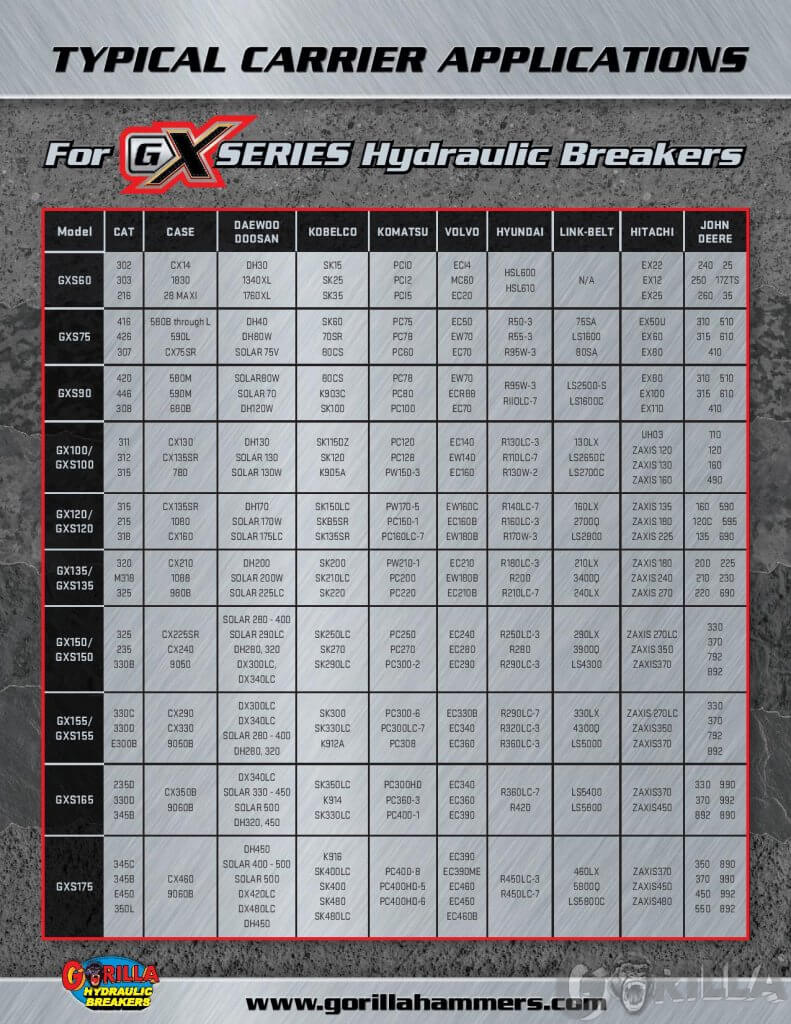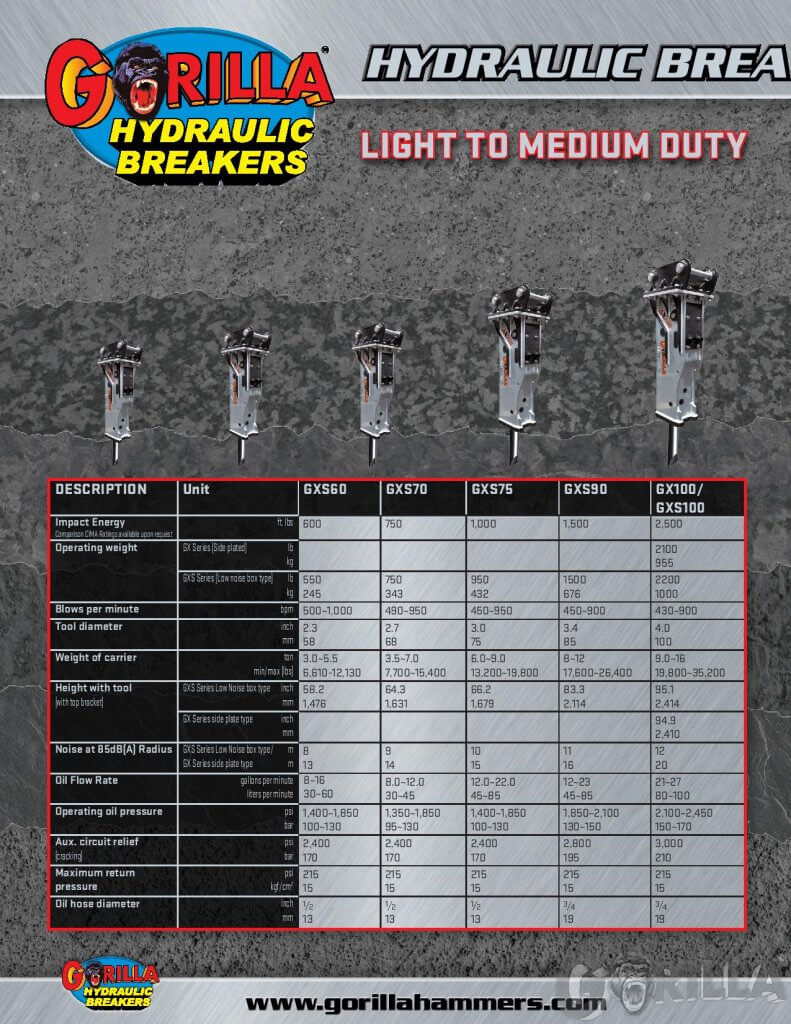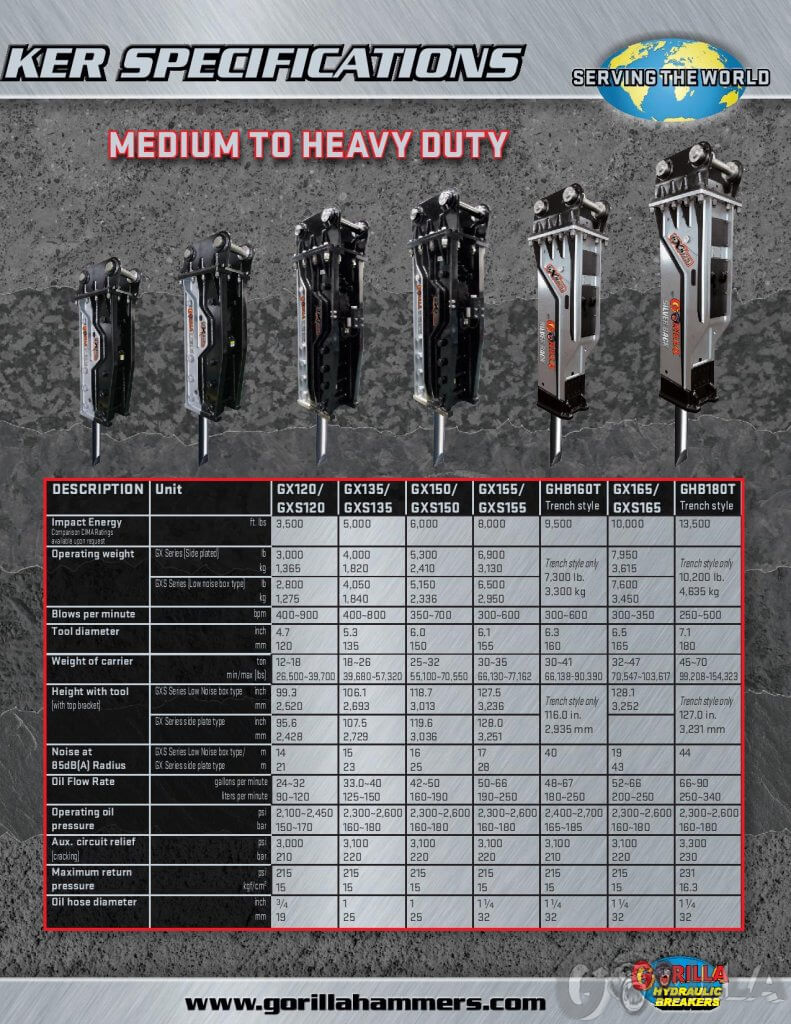Also see hydraulic attachment sizing guide. Our tips on heavy demolition tools usage may help you as well. You can find specifications of virtually all hydraulic breakers (hammers) makes by using our hydraulic breakers (hammers) reference tool.
Sizing Hydraulic Breaker (Hammer)
The breaker must be sized properly for both the work it will do and the carrier on which it will be mounted.
Sizing breaker (hammer) based on type of work
This is the most critical factor in choosing the breaker size.
SMALL HYDRAULIC BREAKERS (HAMMERS): up to 1200-ft.lbs. (1627 Joules), are typically used in concrete and other light duty work.
MEDIUM HYDRAULIC BREAKERS (HAMMERS): 1200 – 4000-ft.lbs. (1627 – 5423 Joules) are used in both concrete and rock applications with limitations on the size and amount of material to be broken.
LARGE HYDRAULIC BREAKERS (HAMMERS): over 4000 ft. lbs. (5423 Joules), are typically used in rock and large scale concrete demolition projects.
BREAKING OVERSIZE MATERIAL: When breaking oversize material the breaker is expected to break the material down the middle into two pieces. This is optimum production. If the operator has to re-position the breaker towards the edge of the rock and gradually downsize the material, production rate slows down. To assess what size of breaker will effectively handle this application, the size and hardness of the material must be known. If a 4 cubic yard piece of hard rock (20,000 psi or greater) needs to be broken in half you will require a 7,500-ft. lb. or larger breaker. If a 2 cubic yard piece of limestone (20,000 psi or less) needs to be broken in half you will require a 3,000 – 5,000-ft. lb. breaker.
TRENCHING: When trenching, the breaker is expected to fracture a solid mass of rock into manageable pieces. The size of the material could be 100’s of cu.yds, and the energy will be quickly absorbed. This is why it is recommended to work from a bench so the rock has somewhere to break out. We recommend when trenching in limestone or medium hard rock, to use a 3,000 – 5,000-ft. lb. breaker. When working in hard material we recommend a 7,500 – 10,000-ft.lb. breaker, and if high production is critical, a 13,500-ft.lb. breaker would be beneficial.
BREAKING CONCRETE: When breaking Concrete, the breaker is expected to penetrate the material, allowing it to crack and shake loose from the reinforcing steel. High frequency breakers tend to provide better performance in this application as it is not the energy per blow, but the fast blow rate that destroys the concrete’s structural integrity. We recommend on concrete walls, footings, and floors to use a 750 – 1,500-ft. lb. breaker. With larger projects, consisting of large footings greater then 4 cubic yards, use a 2,000 – 5,000-ft. lb. breaker. The high production demand of bridge and building demolition requires a 7,500 – 10,000-ft. lb. breaker.
Please refer to the hydraulic breakers reference tool provided on our site.
Sizing breaker (hammer) based on the carrier size
After considering the application work, determine the carrier on which the breaker will be installed. Gorilla Hammers has assigned a ‘Recommended Carrier Weight’ range to each breaker. If the operating weight of the carrier falls within this range, the carrier will safely handle this model of breaker. If the desired breaker falls outside of this recommended carrier weight range, the carriers lifting capacity and oil flow will need to be verified to ensure a proper fit.
Lifting Capacity: Provided the weight of the breaker does not exceed the maximum lifting capacity at any position, the carrier is assumed to be stable. On most loader backhoes and excavators, the maximum lifting capacity is lowest when the boom is at full reach. This is the value that must be compared to the operating weight of the breaker.
Oil Flow and Operating Pressure: A required oil flow range is specified for each breaker. Oil flow to the breaker within this range is adequate for operation. However, for maximum productivity the carrier should be capable of providing the maximum required flow. Compare the maximum oil flow requirement of the breaker with the oil flow capacity of the carrier. Remember the breaker operates at 1500-2500-psi. therefore, oil flow should be evaluated at operating pressure.
Please refer to the following charts, Sizing the Breaker which outlines the recommended carrier weight range.

Mini Excavator
Backhoe
Excavator
Wheel Loader
HOW TO USE THESE CHARTS
There are two ways to select a Gorilla Hydraulic Breaker for your carrier.
If you know your carriers weight, please refer to the charts below.
If you only know your carrier’s make and model number, follow the chart below.
Gorilla’s GX/GXS Series Breakers

Don’t see your carrier?
Please call 1-888-814-6745 or email your Gorilla Hammer Advisor ™ today to choose a breaker for your skid steer, mini or full sized excavator!


